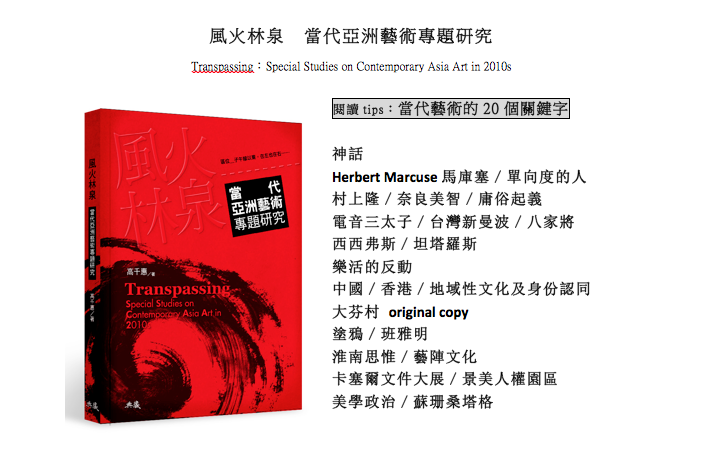2013.09.27 風火林泉 當代亞洲藝術專題研究_新書座談會 7:30pm
Book Launch:Transpassing: Special Studies on Contemporary Asia Art in 2010s
(For English please scroll down)
(Speech in Chinese only)
南方朔推薦 兩岸三地藝評第一人 高千惠新作
解讀當代藝術多重意涵 從北至南三場座談陸續展開
新書座談會
主題:虛線的政治版圖 – 探討亞洲視覺文化中的地域美學意識和政治語言問題
主持人/與談人:南方朔(作家、詩人、評論家及新聞工作者)
講者:高千惠
以台灣這座亞熱帶島嶼為座標向外幅射,高千惠凝聚數年對當代藝術觀察,融合當代藝術、文化書寫、社會剖析、透過藝術覺知的銳利洞見,帶你穿越生活的日常與無常,解讀當代藝術的多重意涵與風貌。
被南方朔盛讚為台灣當代藝評界中「兩岸三地第一人」的高千惠,於2013年九月出版新作《風火林泉:當代亞洲藝術專題研究》,其中集結她多年來對亞洲當代藝術的專業觀察,洞見犀利。同時也將於北中南三地舉辦新書座談會。定居美國芝加哥的高千惠,為此書特地回台參與新書宣傳,期盼透過對亞洲當代藝術的觀察,與國內藝術創作者展開對話與交流激盪,打開島嶼的另一扇藝術之窗。
關於本書書名「風火林泉」的由來,高千惠表示「此書篇幅多書寫於風城芝加哥、香港沙田火炭、高雄林泉街,故以『風火林泉』作為書寫時空與看待亞洲藝術的意象。『風火林泉』是一種活動中的自然狀態,亦以此比喻亞洲當代藝術不可明狀的時空穿梭與人文流動之情境。」高千惠也說:「議題的選擇與圖片的採擷,自然與個人的藝術文化行旅有關,而視線與觀點的出現,同樣涉及了個人文化身分的形塑過程;與亞洲若即若離的距離,遂產生如是另類的敘述與思考。但願這些思考能介入在地的當代亞洲藝術專題研究,也產生一些對話的意義。」
最新著作《風火林泉:當代亞洲藝術專題研究》將於九月中旬上市,高千惠此回返台也將舉辦三場新書座談會,分別為9月27日晚間七點半於台北當代藝術中心、10月2日下午四點於國立台南藝術大學、10月5日下午兩點於高雄市立美術館,並分別邀請知名評論家南方朔、近期以《我們是否工作過量》在藝術圈引起矚目的龔卓軍副教授、以及高美館館長謝佩霓展開對談。座談會線上報名進行中,更多活動詳情可至典藏創意空間查詢,網址:http://www.artouch.com/space/
其他新書座談會時間 (免費入場)
■ 10.02(三)下午4:00 國立台南藝術大學 視覺館五樓大教室
主題:非永遠的後殖民 – 亞洲當代文化藝術的論述建立和可能視野
主持人/與談人:龔卓軍(國立台南藝術大學藝術創作理論研究所副教授)
講者:高千惠
■ 10.05(六)下午2:00 高雄市立美術館B1演講廳
主題:發生在美術館之外 – 探討社會文化圖象的社會性和藝術性問題
主持人/與談人:謝佩霓(高雄市立美術館館長)
講者:高千惠
延伸閱讀:
高千惠簡介 http://interart.nknu.edu.tw/node/83
舊作《叛逆的捉影:當代藝術家的新迷思》南方朔序 http://www.pots.tw/node/788
關於本書更多資料,請詳見以下PDF連結:
一.《風火林泉:當代亞洲藝術專題研究》篇章試閱檔 (本書仍在製作中,試閱檔為三校稿,若文字有疏漏敬請包涵)
二.《風火林泉:當代亞洲藝術專題研究》新書簡介、目錄及序文
Book Launch:Transpassing: Special Studies on Contemporary Asia Art in 2010s
Theme: Imaginary Line of Political Landscape – studies on the regional aesthetic consciousness and the political language problems of the visual culture in Asia
Chair/Guest: Nan Fang Shuo (writer, poet, political commentator and journalist)
Speaker: Kao Chien-Hui (art writer, curator)
Event Introduction
Kao Chien-Hui is praised by Nan Fang Shuo as the leading art critic in contemporary Taiwan who also exerts great influence over the Greater China. Kao will launch her new book “Transpassing: Special Studies on Contemporary Asia Art in 2010s” in September 2013. This new title put together Kao’s observations on contemporary art in Asia over the years, furnishing sharp insights into the field. Kao is currently living in Chicago. She flew back to Taiwan for the book launch, and will also participate in three symposiums held in the north and south Taiwan. Through her observations of contemporary art in Asia as well as dialogue and exchange with Taiwanese artists, Kao hopes to open another window of art for the island.
Introduction to the new title
The title of the book in Chinese can be literally translated as “wind, fire, forest and spring”. According to Kao, the name represents three places where she wrote most of the chapters, including the “Windy City” Chicago, Fo Tan of the Sha Tin District in Hong Kong, and Linquan Street in Kaohsiung City, Taiwan. She therefore used these ideas as the imagery of writing and the ways to look at contemporary art in Asia. Wind, fire, forest and spring are all natural states in activity, and Kao uses them as the metaphors of the indescribable space-time travel and cultural hybridity scenario. Kao also thinks that the choices of the subjects are related to the picking of images, the Nature as well as the personal experiences in arts and culture; the emergence of sights and views is also involved with the process of the shaping of personal cultural identity. The ambiguous distance between Taiwan and Asia thus results in these alternative description and thinking. Kao hopes that she can probe into the local studies on contemporary art in Asia through these thinking, and brings in dialogue meaning accordingly.
About the author
Kao, Chien-Hui, a Chicago-based art critic, independent scholar, received her M.A. in Liberal Arts at the University of Chicago. She was a visiting scholar at Montclair State University, New Jersey, a guest associate professor in the graduate school at Tunhai University, and was guest curator the Taipei Fine Art Museum’s Taiwan Pavilion the 49th Venice Biennale. Author of the books as the following: Art and Culture in the Early 90’s, The Public Art Movement in Chicago, The Art Icons in the 20th Century, A Journey to the Contemporary Art, The Cross-Cultural Exchange of Han and Tang Dynasty Weaving Via the Silk Road. After Origin– On the Topics of Contemporary Chinese art, The Seduction of Daily Life, Nothing about Critique, Rebellion in Silhouette, The Moving Horizon: The Essential Cuide of Uptian Art.
活動記錄
text : 賴佳翎 Vanessa Lai
具備策展人、藝術/文化評論人和藝術教育工作者等多重身分的高千惠,於2013 年九月出版新作《風火林泉:當代亞洲藝術專題研究》,其中集結她多年來對亞洲當代藝術的專業觀察。同時也在北中南三地舉辦座談會,於台北當代藝術中心舉辦的第一場,邀請到的與談人是知名作家與評論人南方朔。
南方朔首先談及他對近代美學趨勢的觀察,他認為美學自1960年代發生了很大的變化,開始往一種奇怪的方向走。在消費主義意識形態高漲的情境下,藝術的意義早已含混不清,不僅被商品化的標籤蓋過,也與政治、社會、環境等領域互動密切,詮釋的空間變得更加開放,卻有外行人看熱鬧的現象。南方朔認為高千惠的文章知識密度強,而這部分也源自於她在文學、哲學、歷史等領域的廣泛吸收。字裡行間,除了向讀者展現亞洲當代藝術的宏觀視野,也能夠帶來一些生活上的啟發。
接著,高千惠與大家討論到關於書名的三大前提問題──什麼是當代?什麼是亞洲?什麼是藝術?《風火林泉:當代亞洲藝術專題研究》其實是源自於一門「亞洲當代藝術」課程,這門課對她而言,能夠談的東西很多也很雜,然而,一直以來相當缺乏具系統性的論述。「風火林泉」代表著風城芝加哥、香港沙田火炭和高雄林泉街,芝加哥是她居住的美國城市、火泉是香港的工廈藝術村落所在、林泉街是台灣高師大附近的街道,這三個地標也是高千惠長期觀察亞洲藝術的特殊視角。高千惠藉此書提出思考:「我是用什麼樣的文化身分在寫這本書?」跨領域且具流動性的觀點與論述,讓這種視點本身便構成了浮動的主體性。
從書籍回應到當日活動的主題──「虛線的政治版圖探討:亞洲視覺文化中的地域美學意識和政治語言問題」,高千惠談及她的成長背景如何影響到她的視野,以及對當代亞洲情境的觀察。比如在新加坡居住的那段時間才回頭認識台灣,或是在他鄉用中文寫作,也意味著她的創作時常是在閱讀西方著作的同時,必須用中文的語意來消化。因此,所謂的亞洲概念對高千惠而言,更多是從對話當中探索異質性和同質性,而從異質性找同質性或許是比較容易的。
除此之外,高千惠也討論到「當代性」對文化定義曖昧含混的狀態,藝術與文化之間的關係變得更加模糊而不明確,甚至有越來越多使「文化」取代「藝術」的觀點。藉此,高千惠從近幾年的觀察當中舉出幾項有關文化裡的政治美學的案例,像是藝術界如何表達自身訴求或執行具政治性意義的行動以回應當代社會問題,也反映出藝術長期以來對自主性的焦慮,在今天也同樣地掙扎於資本競爭的社會。
在當代亞洲現代化過程的脈絡下,仍然有必要持續地探尋其中的社會性意義,以及意識形態如何藉著文化符碼被使用或生產,《風火林泉》這本書將作為一個開展更多討論的起點。
更多照片 http://www.facebook.com/media/set/?set=a.10151956140914878.1073741860.361110184877&type=3




